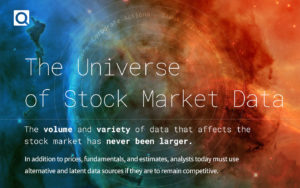3 Little Known Factors That Can Affect Your Portfolio: Quandl’s Guide
So, I saw something the other day that I’ve never seen before.
I was coming out of a grocery store that was up a hill from a major street, and a truck was approaching the intersection. The truck was hauling a bulldozer on a flatbed trailer and, as the truck approached the intersection, it starting honking- a lot like an emergency vehicle moving through an intersection.
It was obvious that the driver had been thought the intersection before, because as drivers head up the hill toward the light, it’s difficult for crossing traffic to see who is coming through the intersection.
Using wisdom to get better results.
Have a question about personal finance or entrepreneurship? Join the Ask Me Anything live chats on Conference Room.
I was reminded of the truck driver when I recently reviewed the Quandl stock market data guide, and I think this guide brings up some great points that every investor needs to know.
#1- Free stock quotes: You get what you pay for
Now, I’m not saying that free stock quotes are bad- I think it’s great that investors have so many sites that provide stock quotes. The problem is how free stock quotes are used.
The stocks for most large companies- companies that you invest in- trade on multiple exchanges. Assume, for example, that your mutual fund owns IBM common stock, and that the stock trades on the NYSE, as well as other exchanges. Your portfolio manager needs to have real time stock quotes for all of the exchanges, in order to take advantage of the best price, and this is particularly important if the portfolio manager needs to get a large number of shares bought or sold.
#2- Standardized rules make data comparable
The Standard and Exchange Commission (SEC) oversees companies that issue stock to the general public, and the financial information in a prospectus must follow a set of standards, including the need for audited financial statements. Also, Generally Accepted Accounting Principles (GAAP) requires accounting data to meet a set of standards.
These rules benefit investors, because standardized financial data to easier to compare company results. If an analyst looks a firm’s EBITDA (earnings before interest, taxes, depreciation and amortization), which is a measurement of company earnings, the manager can compare a $100 million clothing manufacturer with a $1 billion construction company. If you can understand a few key financial ratios, you can use a ratio to assess any public company.
#3- An earnings machine
When you buy a stock, you’re buying an earnings machine, and specifically the ability of a company to generate earnings and collect those earnings in cash. One type of stock analysis takes the net present value of the cash flows generated by the business each year for investors, which means cash dividends and any other distributions.
If a business can generate earnings, it can pay a dividend from those earnings- in cash. Keep this earnings machine concept in mind when considering the value of a stock.
Take a look at the Quandl stock market data guide- it’s a great learning tool for investors. As always, these posts are for informational purposes only. Consult a financial or tax advisor as needed.
Ken Boyd
Author: Cost Accounting for Dummies, Accounting All-In-One for Dummies, The CPA Exam for Dummies and 1,001 Accounting Questions for Dummies
(email) ken@stltest.net
(website and blog) https://www.accountingaccidentally.com/
(you tube channel) kenboydstl

